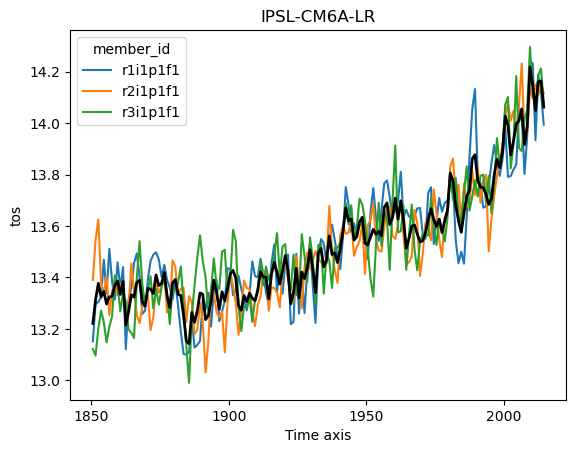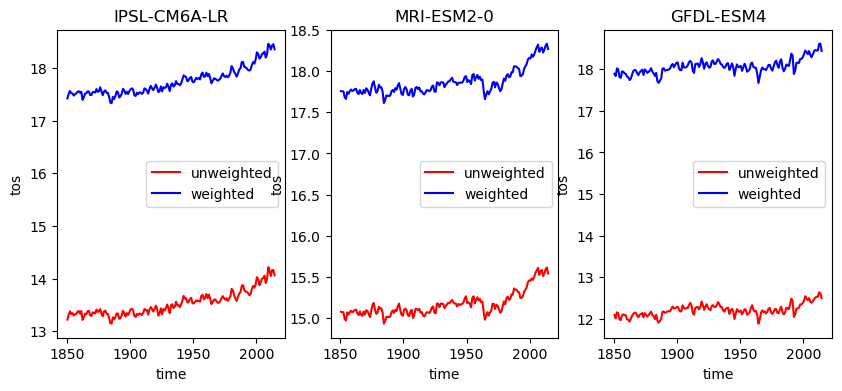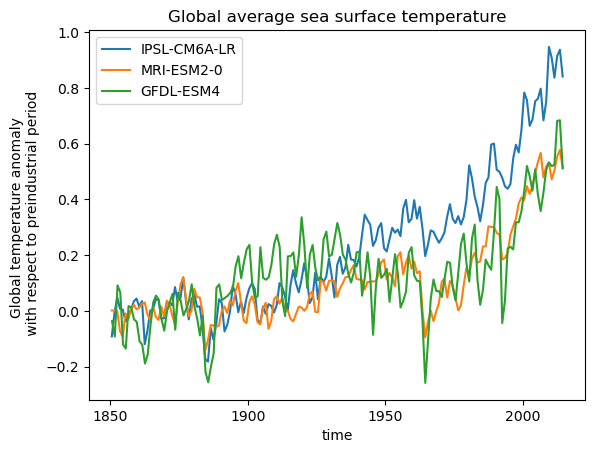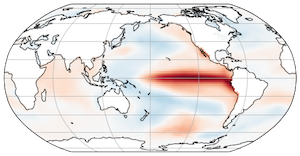Working with output from many different CMIP6 climate models
Working with output from many different CMIP6 climate models#
Climate modeling has been a cornerstone of understanding our climate and the consequences of continued emissions of greenhouse gases for decades. Much of the recent efforts in the community have been focus on model intercomparison projects (MIPs), which invite submissions of many different modeling groups around the world to run their models (which are all set up slightly different) under centralized forcing scenarios. These results can then be analyzed and the spread between different models can give an idea about the certainty of these predictions. The recent Coupled Model Intercomparison Project Phase 6 (CMIP6) represents an international effort to represent the state-of-the-art knowledge about how the climate system might evolve in the future and informs much of the [Intergovernmental Panel on Climate Change Report](Intergovernmental Panel on Climate Change Report.
In this lecture we will learn how to quickly search and analyze CMIP6 data with Pangeo tools in the cloud, a process that using the ‘download and analyze’ workflow often becomes prohibitively slow and inefficient due to the sheer scale of the data.
The basis for this workflow are the analysis-ready-cloud-optimized repositories of CMIP6 data, which are currently maintained by the pangeo community and publicly available on both Google Cloud Storage and Amazon S3 as a collection of zarr stores.
The cloud native approach enables scientific results to be fully reproducible, encouraging to build onto and collaborate on scientific results.
from xmip.preprocessing import combined_preprocessing
from xmip.utils import google_cmip_col
from xmip.postprocessing import match_metrics
import matplotlib.pyplot as plt
The first thing we have to do is to get an overview of all the data available. In this case we are using intake-esm to load a collection of zarr stores on Google Cloud Storage, but there are other options to access the data too.
Lets create a collection object and look at it
col = google_cmip_col()
col
pangeo-cmip6 catalog with 7674 dataset(s) from 514818 asset(s):
| unique | |
|---|---|
| activity_id | 18 |
| institution_id | 36 |
| source_id | 88 |
| experiment_id | 170 |
| member_id | 657 |
| table_id | 37 |
| variable_id | 700 |
| grid_label | 10 |
| zstore | 514818 |
| dcpp_init_year | 60 |
| version | 736 |
| derived_variable_id | 0 |
This object describes all the available data (over 500k single zarr stores!). The rows describe different ‘facets’ that can be used to search and query subsets of the data. For detailed info on each of the facets please refer to this document.
So obviously we never want to work with all the data. Lets check out how to get a subset.
First we need to understand a bit better what all these facets mean and how to see which ones are in the full collection. Lets start with the experiment_id: This is the prescribed forcing for a particular MIP that is exactly the same across all different models. We can look at the values of the collection as a pandas dataframe to convieniently list all values.
col.df['experiment_id'].unique()
array(['highresSST-present', 'piControl', 'control-1950', 'hist-1950',
'historical', 'amip', 'abrupt-4xCO2', 'abrupt-2xCO2',
'abrupt-0p5xCO2', '1pctCO2', 'ssp585', 'esm-piControl', 'esm-hist',
'hist-piAer', 'histSST-1950HC', 'ssp245', 'hist-1950HC', 'histSST',
'piClim-2xVOC', 'piClim-2xNOx', 'piClim-2xdust', 'piClim-2xss',
'piClim-histall', 'hist-piNTCF', 'histSST-piNTCF',
'aqua-control-lwoff', 'piClim-lu', 'histSST-piO3', 'piClim-CH4',
'piClim-NTCF', 'piClim-NOx', 'piClim-O3', 'piClim-HC',
'faf-heat-NA0pct', 'ssp370SST-lowCH4', 'piClim-VOC',
'ssp370-lowNTCF', 'piClim-control', 'piClim-aer', 'hist-aer',
'faf-heat', 'faf-heat-NA50pct', 'ssp370SST-lowNTCF',
'ssp370SST-ssp126Lu', 'ssp370SST', 'ssp370pdSST', 'histSST-piAer',
'piClim-ghg', 'piClim-anthro', 'faf-all', 'hist-nat', 'hist-GHG',
'ssp119', 'piClim-histnat', 'piClim-4xCO2', 'ssp370',
'piClim-histghg', 'highresSST-future', 'esm-ssp585-ssp126Lu',
'ssp126-ssp370Lu', 'ssp370-ssp126Lu', 'land-noLu', 'histSST-piCH4',
'ssp126', 'esm-pi-CO2pulse', 'amip-hist', 'piClim-histaer',
'amip-4xCO2', 'faf-water', 'faf-passiveheat', '1pctCO2-rad',
'faf-stress', '1pctCO2-bgc', 'aqua-control', 'amip-future4K',
'amip-p4K', 'aqua-p4K', 'amip-lwoff', 'amip-m4K', 'aqua-4xCO2',
'amip-p4K-lwoff', 'hist-noLu', '1pctCO2-cdr',
'land-hist-altStartYear', 'land-hist', 'omip1', 'esm-pi-cdr-pulse',
'esm-ssp585', 'abrupt-solp4p', 'piControl-spinup', 'hist-stratO3',
'abrupt-solm4p', 'midHolocene', 'lig127k', 'aqua-p4K-lwoff',
'esm-piControl-spinup', 'ssp245-GHG', 'ssp245-nat',
'dcppC-amv-neg', 'dcppC-amv-ExTrop-neg', 'dcppC-atl-control',
'dcppC-amv-pos', 'dcppC-ipv-NexTrop-neg', 'dcppC-ipv-NexTrop-pos',
'dcppC-atl-pacemaker', 'dcppC-amv-ExTrop-pos',
'dcppC-amv-Trop-neg', 'dcppC-pac-control', 'dcppC-ipv-pos',
'dcppC-pac-pacemaker', 'dcppC-ipv-neg', 'dcppC-amv-Trop-pos',
'piClim-BC', 'piClim-2xfire', 'piClim-SO2', 'piClim-OC',
'piClim-N2O', 'piClim-2xDMS', 'ssp460', 'ssp434', 'ssp534-over',
'deforest-globe', 'historical-cmip5', 'hist-bgc',
'piControl-cmip5', 'rcp26-cmip5', 'rcp45-cmip5', 'rcp85-cmip5',
'pdSST-piArcSIC', 'pdSST-piAntSIC', 'piSST-piSIC', 'piSST-pdSIC',
'ssp245-stratO3', 'hist-sol', 'hist-CO2', 'hist-volc',
'hist-totalO3', 'hist-nat-cmip5', 'hist-aer-cmip5',
'hist-GHG-cmip5', 'pdSST-futAntSIC', 'futSST-pdSIC', 'pdSST-pdSIC',
'ssp245-aer', 'pdSST-futArcSIC', 'dcppA-hindcast', 'dcppA-assim',
'dcppC-hindcast-noPinatubo', 'dcppC-hindcast-noElChichon',
'dcppC-hindcast-noAgung', 'ssp245-cov-modgreen',
'ssp245-cov-fossil', 'ssp245-cov-strgreen', 'ssp245-covid', 'lgm',
'ssp585-bgc', '1pctCO2to4x-withism', '1pctCO2-4xext',
'hist-resIPO', 'past1000', 'pa-futArcSIC', 'pa-pdSIC',
'historical-ext', 'pdSST-futArcSICSIT', 'pdSST-futOkhotskSIC',
'pdSST-futBKSeasSIC', 'pa-piArcSIC', 'pa-piAntSIC', 'pa-futAntSIC',
'pdSST-pdSICSIT'], dtype=object)
The experiments you are probably most interested in are the following:
piControl: In most cases this is the ‘spin up’ phase of the model, where it is run with a constant forcing (representing pre-industrial greenhouse gas concentrations)historical: This experiment is run with the observed forcing in the past.ssp***: A set of “Shared Socioeconomic Pathways” which represent different combined scenarios of future greenhouse gas emissions and other socio-economic indicators (Explainer). These are a fairly complex topic, but to simplify this for our purposes here we can treatssp585as the ‘worst-case’ andssp245as ‘middle-of-the-road’.
You can explore the available models (source_id) in the same way as above:
col.df['source_id'].unique()
array(['CMCC-CM2-HR4', 'EC-Earth3P-HR', 'HadGEM3-GC31-MM',
'HadGEM3-GC31-HM', 'HadGEM3-GC31-LM', 'EC-Earth3P', 'ECMWF-IFS-HR',
'ECMWF-IFS-LR', 'HadGEM3-GC31-LL', 'CMCC-CM2-VHR4', 'GFDL-CM4',
'GFDL-AM4', 'IPSL-CM6A-LR', 'E3SM-1-0', 'CNRM-CM6-1', 'GFDL-ESM4',
'GFDL-ESM2M', 'GFDL-CM4C192', 'GFDL-OM4p5B', 'GISS-E2-1-G',
'GISS-E2-1-H', 'CNRM-ESM2-1', 'BCC-CSM2-MR', 'BCC-ESM1', 'MIROC6',
'AWI-CM-1-1-MR', 'EC-Earth3-LR', 'IPSL-CM6A-ATM-HR', 'CESM2',
'CESM2-WACCM', 'CNRM-CM6-1-HR', 'MRI-ESM2-0', 'SAM0-UNICON',
'GISS-E2-1-G-CC', 'UKESM1-0-LL', 'EC-Earth3', 'EC-Earth3-Veg',
'FGOALS-f3-L', 'CanESM5', 'CanESM5-CanOE', 'INM-CM4-8',
'INM-CM5-0', 'NESM3', 'MPI-ESM-1-2-HAM', 'CAMS-CSM1-0',
'MPI-ESM1-2-LR', 'MPI-ESM1-2-HR', 'MRI-AGCM3-2-H', 'MRI-AGCM3-2-S',
'MCM-UA-1-0', 'INM-CM5-H', 'KACE-1-0-G', 'NorESM2-LM',
'FGOALS-f3-H', 'FGOALS-g3', 'MIROC-ES2L', 'FIO-ESM-2-0', 'NorCPM1',
'NorESM1-F', 'MPI-ESM1-2-XR', 'CESM1-1-CAM5-CMIP5', 'E3SM-1-1',
'KIOST-ESM', 'ACCESS-CM2', 'NorESM2-MM', 'ACCESS-ESM1-5',
'IITM-ESM', 'GISS-E2-2-G', 'CESM2-FV2', 'GISS-E2-2-H',
'CESM2-WACCM-FV2', 'CIESM', 'E3SM-1-1-ECA', 'TaiESM1',
'AWI-ESM-1-1-LR', 'EC-Earth3-Veg-LR', 'CMCC-ESM2', 'CMCC-CM2-SR5',
'EC-Earth3-AerChem', 'IPSL-CM6A-LR-INCA', 'IPSL-CM5A2-INCA',
'BCC-CSM2-HR', 'EC-Earth3P-VHR', 'CESM1-WACCM-SC', 'CAS-ESM2-0',
'EC-Earth3-CC', 'MIROC-ES2H', 'ICON-ESM-LR'], dtype=object)
Now you want to decide what variable (variable_id) you want to look at and in conjunction what time frequency of output (table_id) is available. This handy spreadsheet can help you find the value for variable_id and the available time frequencies (table_id).
Lets look at an example for monthly ('table_id'='Omon') sea surface temperature ('variable_id'='tos') for the historical experiment:
cat = col.search(
variable_id='tos', # ocean surface temperature
table_id='Omon',
experiment_id='historical',
source_id=['GFDL-ESM4'],
)
cat
pangeo-cmip6 catalog with 2 dataset(s) from 6 asset(s):
| unique | |
|---|---|
| activity_id | 1 |
| institution_id | 1 |
| source_id | 1 |
| experiment_id | 1 |
| member_id | 3 |
| table_id | 1 |
| variable_id | 1 |
| grid_label | 2 |
| zstore | 6 |
| dcpp_init_year | 0 |
| version | 2 |
| derived_variable_id | 0 |
The last facet we need to discuss is member_id and grid_label:
You can see here that we have 3 member_id values for the given query.
cat.df['member_id'].unique()
array(['r3i1p1f1', 'r2i1p1f1', 'r1i1p1f1'], dtype=object)
This indicates that for this particular model/experiment 3 ensemble members where run with varing realizations/initial_condiditions/physics/forcing or a combination thereof. The naming is explained in thisdocument:
Example of a variant_label: if realization_index=2, initialization_index=1, physics_index=3, and forcing_index=233, then variant_label = “r2i1p3f233”.
There can be many more members for some particular models, which provides an opportunity to investigate internal variability of the climate system as compared to forced signals.
Finally there are two values of grid_label
cat.df['grid_label'].unique()
array(['gr', 'gn'], dtype=object)
The value gn always stands for the native model grid (which can be quite complex but preserves the most detail) and gr indicates data that has been regridded on regular lon/lat intervals.
Now that you know how to query and subset the collection, it is time to actually load in some model data as xarray datasets!
# create a smaller catalog from the full collection using faceted search
cat = col.search(
variable_id='tos', # Ocean surface temperature
experiment_id='historical', # only runs for the historical forcing period
table_id='Omon', # monthly oceanic data
grid_label='gn', #native model grid only
source_id=['IPSL-CM6A-LR', 'MRI-ESM2-0', 'GFDL-ESM4'], # only choosing a few models here, there are many more!
member_id=['r1i1p1f1', 'r2i1p1f1', 'r3i1p1f1'], #lets restrict us here to only a few members, you can modify this later to experiment.
)
# read all datasets into a dictionary but apply the xmip preprocessing before
ddict = cat.to_dataset_dict(
preprocess=combined_preprocessing,
xarray_open_kwargs={'use_cftime':True},
)
--> The keys in the returned dictionary of datasets are constructed as follows:
'activity_id.institution_id.source_id.experiment_id.table_id.grid_label'
/srv/conda/envs/notebook/lib/python3.9/site-packages/xmip/preprocessing.py:106: UserWarning: Renaming failed with 'area'
warnings.warn(f"Renaming failed with {e}")
/srv/conda/envs/notebook/lib/python3.9/site-packages/xmip/preprocessing.py:106: UserWarning: Renaming failed with 'time_bounds'
warnings.warn(f"Renaming failed with {e}")
/srv/conda/envs/notebook/lib/python3.9/site-packages/xmip/preprocessing.py:106: UserWarning: Renaming failed with 'tos'
warnings.warn(f"Renaming failed with {e}")
/srv/conda/envs/notebook/lib/python3.9/site-packages/xmip/preprocessing.py:106: UserWarning: Renaming failed with 'tos'
warnings.warn(f"Renaming failed with {e}")
/srv/conda/envs/notebook/lib/python3.9/site-packages/xmip/preprocessing.py:106: UserWarning: Renaming failed with the new name 'lon_bounds' conflicts
warnings.warn(f"Renaming failed with {e}")
/srv/conda/envs/notebook/lib/python3.9/site-packages/xmip/preprocessing.py:106: UserWarning: Renaming failed with the new name 'lat_bounds' conflicts
warnings.warn(f"Renaming failed with {e}")
/srv/conda/envs/notebook/lib/python3.9/site-packages/xmip/preprocessing.py:83: UserWarning: rename 'bnds' to 'bnds' does not create an index anymore. Try using swap_dims instead or use set_index after rename to create an indexed coordinate.
return obj.rename({kk: vv for kk, vv in rdict.items() if kk in obj.dims})
/srv/conda/envs/notebook/lib/python3.9/site-packages/xmip/preprocessing.py:106: UserWarning: Renaming failed with 'lat'
warnings.warn(f"Renaming failed with {e}")
/srv/conda/envs/notebook/lib/python3.9/site-packages/xmip/preprocessing.py:106: UserWarning: Renaming failed with 'lon'
warnings.warn(f"Renaming failed with {e}")
/srv/conda/envs/notebook/lib/python3.9/site-packages/xmip/preprocessing.py:106: UserWarning: Renaming failed with 'tos'
warnings.warn(f"Renaming failed with {e}")
/srv/conda/envs/notebook/lib/python3.9/site-packages/xmip/preprocessing.py:106: UserWarning: Renaming failed with 'area'
warnings.warn(f"Renaming failed with {e}")
/srv/conda/envs/notebook/lib/python3.9/site-packages/xmip/preprocessing.py:106: UserWarning: Renaming failed with 'time_bounds'
warnings.warn(f"Renaming failed with {e}")
/srv/conda/envs/notebook/lib/python3.9/site-packages/xmip/preprocessing.py:106: UserWarning: Renaming failed with 'tos'
warnings.warn(f"Renaming failed with {e}")
/srv/conda/envs/notebook/lib/python3.9/site-packages/xmip/preprocessing.py:106: UserWarning: Renaming failed with 'tos'
warnings.warn(f"Renaming failed with {e}")
/srv/conda/envs/notebook/lib/python3.9/site-packages/xmip/preprocessing.py:106: UserWarning: Renaming failed with the new name 'lon_bounds' conflicts
warnings.warn(f"Renaming failed with {e}")
/srv/conda/envs/notebook/lib/python3.9/site-packages/xmip/preprocessing.py:106: UserWarning: Renaming failed with the new name 'lat_bounds' conflicts
warnings.warn(f"Renaming failed with {e}")
/srv/conda/envs/notebook/lib/python3.9/site-packages/xmip/preprocessing.py:83: UserWarning: rename 'bnds' to 'bnds' does not create an index anymore. Try using swap_dims instead or use set_index after rename to create an indexed coordinate.
return obj.rename({kk: vv for kk, vv in rdict.items() if kk in obj.dims})
/srv/conda/envs/notebook/lib/python3.9/site-packages/xmip/preprocessing.py:106: UserWarning: Renaming failed with 'lat'
warnings.warn(f"Renaming failed with {e}")
/srv/conda/envs/notebook/lib/python3.9/site-packages/xmip/preprocessing.py:106: UserWarning: Renaming failed with 'lon'
warnings.warn(f"Renaming failed with {e}")
/srv/conda/envs/notebook/lib/python3.9/site-packages/xmip/preprocessing.py:106: UserWarning: Renaming failed with 'tos'
warnings.warn(f"Renaming failed with {e}")
/srv/conda/envs/notebook/lib/python3.9/site-packages/xmip/preprocessing.py:106: UserWarning: Renaming failed with 'area'
warnings.warn(f"Renaming failed with {e}")
/srv/conda/envs/notebook/lib/python3.9/site-packages/xmip/preprocessing.py:106: UserWarning: Renaming failed with 'time_bounds'
warnings.warn(f"Renaming failed with {e}")
/srv/conda/envs/notebook/lib/python3.9/site-packages/xmip/preprocessing.py:106: UserWarning: Renaming failed with 'tos'
warnings.warn(f"Renaming failed with {e}")
/srv/conda/envs/notebook/lib/python3.9/site-packages/xmip/preprocessing.py:106: UserWarning: Renaming failed with 'tos'
warnings.warn(f"Renaming failed with {e}")
/srv/conda/envs/notebook/lib/python3.9/site-packages/xmip/preprocessing.py:106: UserWarning: Renaming failed with the new name 'lon_bounds' conflicts
warnings.warn(f"Renaming failed with {e}")
/srv/conda/envs/notebook/lib/python3.9/site-packages/xmip/preprocessing.py:106: UserWarning: Renaming failed with the new name 'lat_bounds' conflicts
warnings.warn(f"Renaming failed with {e}")
/srv/conda/envs/notebook/lib/python3.9/site-packages/xmip/preprocessing.py:83: UserWarning: rename 'bnds' to 'bnds' does not create an index anymore. Try using swap_dims instead or use set_index after rename to create an indexed coordinate.
return obj.rename({kk: vv for kk, vv in rdict.items() if kk in obj.dims})
/srv/conda/envs/notebook/lib/python3.9/site-packages/xmip/preprocessing.py:106: UserWarning: Renaming failed with 'lat'
warnings.warn(f"Renaming failed with {e}")
/srv/conda/envs/notebook/lib/python3.9/site-packages/xmip/preprocessing.py:106: UserWarning: Renaming failed with 'lon'
warnings.warn(f"Renaming failed with {e}")
/srv/conda/envs/notebook/lib/python3.9/site-packages/xmip/preprocessing.py:106: UserWarning: Renaming failed with 'tos'
warnings.warn(f"Renaming failed with {e}")
Here we did two things:
We searched the full collection based on a combination of facets like the variable, the experiment and only a test set of models.
We loaded the datasets into a dictionary of xarray datasets (note they are not loaded into memory, but instead these are lazyly loaded dask arrays – more on this in the following lectures).
list(ddict.keys())
['CMIP.IPSL.IPSL-CM6A-LR.historical.Omon.gn',
'CMIP.MRI.MRI-ESM2-0.historical.Omon.gn',
'CMIP.NOAA-GFDL.GFDL-ESM4.historical.Omon.gn']
You can see that we have three different models. Lets look at them in a bit more detail to understand the layout:
ddict['CMIP.IPSL.IPSL-CM6A-LR.historical.Omon.gn']
<xarray.Dataset>
Dimensions: (y: 332, x: 362, member_id: 3, dcpp_init_year: 1,
time: 1980, vertex: 4, bnds: 2)
Coordinates: (12/13)
area (y, x) float32 dask.array<chunksize=(332, 362), meta=np.ndarray>
lat_verticies (y, x, vertex) float32 dask.array<chunksize=(332, 362, 4), meta=np.ndarray>
lon_verticies (y, x, vertex) float32 dask.array<chunksize=(332, 362, 4), meta=np.ndarray>
lat (y, x) float32 dask.array<chunksize=(332, 362), meta=np.ndarray>
lon (y, x) float32 dask.array<chunksize=(332, 362), meta=np.ndarray>
* time (time) object 1850-01-16 12:00:00 ... 2014-12-16 12:00:00
... ...
* y (y) int64 0 1 2 3 4 5 6 7 ... 325 326 327 328 329 330 331
* x (x) int64 0 1 2 3 4 5 6 7 ... 355 356 357 358 359 360 361
lon_bounds (bnds, y, x) float32 dask.array<chunksize=(1, 332, 362), meta=np.ndarray>
lat_bounds (bnds, y, x) float32 dask.array<chunksize=(1, 332, 362), meta=np.ndarray>
* member_id (member_id) object 'r1i1p1f1' 'r2i1p1f1' 'r3i1p1f1'
* dcpp_init_year (dcpp_init_year) float64 nan
Dimensions without coordinates: vertex, bnds
Data variables:
tos (member_id, dcpp_init_year, time, y, x) float32 dask.array<chunksize=(1, 1, 251, 332, 362), meta=np.ndarray>
Attributes: (12/52)
CMIP6_CV_version: cv=6.2.3.5-2-g63b123e
Conventions: CF-1.7 CMIP-6.2
EXPID: historical
NCO: "4.6.0"
activity_id: CMIP
branch_method: standard
... ...
intake_esm_attrs:variable_id: tos
intake_esm_attrs:grid_label: gn
intake_esm_attrs:version: 20180803
intake_esm_attrs:_data_format_: zarr
variant_info: Restart from another point in piControl...
intake_esm_dataset_key: CMIP.IPSL.IPSL-CM6A-LR.historical.Omon.gnddict['CMIP.NOAA-GFDL.GFDL-ESM4.historical.Omon.gn']
<xarray.Dataset>
Dimensions: (member_id: 3, dcpp_init_year: 1, time: 1980, y: 576,
x: 720, vertex: 4, bnds: 2)
Coordinates:
* x (x) float64 -299.8 -299.2 -298.8 ... 58.75 59.25 59.75
* y (y) float64 -77.91 -77.72 -77.54 ... 89.47 89.68 89.89
lat (y, x) float32 dask.array<chunksize=(576, 720), meta=np.ndarray>
lat_verticies (y, x, vertex) float32 dask.array<chunksize=(576, 720, 4), meta=np.ndarray>
lon (y, x) float32 dask.array<chunksize=(576, 720), meta=np.ndarray>
lon_verticies (y, x, vertex) float32 dask.array<chunksize=(576, 720, 4), meta=np.ndarray>
* time (time) object 1850-01-16 12:00:00 ... 2014-12-16 12:00:00
time_bounds (time, bnds) object dask.array<chunksize=(1980, 2), meta=np.ndarray>
lon_bounds (bnds, y, x) float32 dask.array<chunksize=(1, 576, 720), meta=np.ndarray>
lat_bounds (bnds, y, x) float32 dask.array<chunksize=(1, 576, 720), meta=np.ndarray>
* member_id (member_id) object 'r1i1p1f1' 'r2i1p1f1' 'r3i1p1f1'
* dcpp_init_year (dcpp_init_year) float64 nan
Dimensions without coordinates: vertex, bnds
Data variables:
tos (member_id, dcpp_init_year, time, y, x) float32 dask.array<chunksize=(1, 1, 64, 576, 720), meta=np.ndarray>
Attributes: (12/48)
Conventions: CF-1.7 CMIP-6.0 UGRID-1.0
activity_id: CMIP
branch_method: standard
branch_time_in_child: 0.0
comment: <null ref>
contact: gfdl.climate.model.info@noaa.gov
... ...
intake_esm_attrs:experiment_id: historical
intake_esm_attrs:table_id: Omon
intake_esm_attrs:variable_id: tos
intake_esm_attrs:grid_label: gn
intake_esm_attrs:_data_format_: zarr
intake_esm_dataset_key: CMIP.NOAA-GFDL.GFDL-ESM4.historical.Omo...You can see that both datasets have the same names for many of the coordinates (e.g. ‘x’ and ‘y’ for the logical indices in zonal and meridional direction). This is actually not always the case for the raw CMIP6 data, which is why xMIP was developed in an effort to crowdsource these common data-cleaning tasks. For this example we only use the combined_preprocessing function which fixes some of the naming, but check out the docs to see more helpful code for CMIP analysis.
Ok but now lets analyze the data! Using what we know about xarray we can get a timeseries of the global sea surface temperature:
for name, ds in ddict.items():
# construct yearly global mean timeseries
mean_temp = ds.tos.mean(['x', 'y']).coarsen(time=12).mean()
plt.figure()
mean_temp.plot(hue='member_id')
# lets also plot the average over all members
mean_temp.mean('member_id').plot(color='k', linewidth=2)
plt.title(ds.attrs['source_id']) #Extract the model name right from the dataset metadata
plt.show()



But wait! This is not exactly right. We need to weight the spatial mean by the area of each grid cell, since the area varies based on the position on the globe (and the particularities of the curvilinear grid used in each model). But we can easily query the cell area (by modifying the query from above slightly) and then match them to the data using xmip
# Repeat the above steps to get the cell area matching the temperature we loaded earlier
cat_area = col.search(
variable_id='areacello', # the cell area is a different variable in the collection
table_id='Ofx', # since area is not varying in time we need to specify a different table_id
experiment_id='historical', # Same as before
grid_label='gn', # Same as before
source_id=['IPSL-CM6A-LR', 'MRI-ESM2-0', 'GFDL-ESM4'], # Same as before
member_id=['r1i1p1f1', 'r2i1p1f1', 'r3i1p1f1'], # Same as before
)
# read all datasets into a dictionary (make sure to apply the same preprocessing as before!)
ddict_area = cat_area.to_dataset_dict(
preprocess=combined_preprocessing,
xarray_open_kwargs={'use_cftime':True}
)
--> The keys in the returned dictionary of datasets are constructed as follows:
'activity_id.institution_id.source_id.experiment_id.table_id.grid_label'
/srv/conda/envs/notebook/lib/python3.9/site-packages/xmip/preprocessing.py:106: UserWarning: Renaming failed with 'area'
warnings.warn(f"Renaming failed with {e}")
/srv/conda/envs/notebook/lib/python3.9/site-packages/xmip/preprocessing.py:106: UserWarning: Renaming failed with 'areacello'
warnings.warn(f"Renaming failed with {e}")
/srv/conda/envs/notebook/lib/python3.9/site-packages/xmip/preprocessing.py:106: UserWarning: Renaming failed with 'area'
warnings.warn(f"Renaming failed with {e}")
/srv/conda/envs/notebook/lib/python3.9/site-packages/xmip/preprocessing.py:106: UserWarning: Renaming failed with 'areacello'
warnings.warn(f"Renaming failed with {e}")
/srv/conda/envs/notebook/lib/python3.9/site-packages/xmip/preprocessing.py:106: UserWarning: Renaming failed with 'area'
warnings.warn(f"Renaming failed with {e}")
/srv/conda/envs/notebook/lib/python3.9/site-packages/xmip/preprocessing.py:106: UserWarning: Renaming failed with 'areacello'
warnings.warn(f"Renaming failed with {e}")
/srv/conda/envs/notebook/lib/python3.9/site-packages/xmip/preprocessing.py:106: UserWarning: Renaming failed with 'areacello'
warnings.warn(f"Renaming failed with {e}")
/srv/conda/envs/notebook/lib/python3.9/site-packages/xmip/preprocessing.py:106: UserWarning: Renaming failed with 'lat'
warnings.warn(f"Renaming failed with {e}")
/srv/conda/envs/notebook/lib/python3.9/site-packages/xmip/preprocessing.py:106: UserWarning: Renaming failed with 'lon'
warnings.warn(f"Renaming failed with {e}")
/srv/conda/envs/notebook/lib/python3.9/site-packages/xmip/preprocessing.py:106: UserWarning: Renaming failed with 'areacello'
warnings.warn(f"Renaming failed with {e}")
/srv/conda/envs/notebook/lib/python3.9/site-packages/xmip/preprocessing.py:106: UserWarning: Renaming failed with the new name 'lon_bounds' conflicts
warnings.warn(f"Renaming failed with {e}")
/srv/conda/envs/notebook/lib/python3.9/site-packages/xmip/preprocessing.py:106: UserWarning: Renaming failed with the new name 'lat_bounds' conflicts
warnings.warn(f"Renaming failed with {e}")
/srv/conda/envs/notebook/lib/python3.9/site-packages/xmip/preprocessing.py:106: UserWarning: Renaming failed with 'areacello'
warnings.warn(f"Renaming failed with {e}")
/srv/conda/envs/notebook/lib/python3.9/site-packages/xmip/preprocessing.py:106: UserWarning: Renaming failed with the new name 'lon_bounds' conflicts
warnings.warn(f"Renaming failed with {e}")
/srv/conda/envs/notebook/lib/python3.9/site-packages/xmip/preprocessing.py:106: UserWarning: Renaming failed with the new name 'lat_bounds' conflicts
warnings.warn(f"Renaming failed with {e}")
/srv/conda/envs/notebook/lib/python3.9/site-packages/xmip/preprocessing.py:106: UserWarning: Renaming failed with 'areacello'
warnings.warn(f"Renaming failed with {e}")
/srv/conda/envs/notebook/lib/python3.9/site-packages/xmip/preprocessing.py:106: UserWarning: Renaming failed with the new name 'lon_bounds' conflicts
warnings.warn(f"Renaming failed with {e}")
/srv/conda/envs/notebook/lib/python3.9/site-packages/xmip/preprocessing.py:106: UserWarning: Renaming failed with the new name 'lat_bounds' conflicts
warnings.warn(f"Renaming failed with {e}")
list(ddict_area.keys())
['CMIP.NOAA-GFDL.GFDL-ESM4.historical.Ofx.gn',
'CMIP.IPSL.IPSL-CM6A-LR.historical.Ofx.gn',
'CMIP.MRI.MRI-ESM2-0.historical.Ofx.gn']
You can inspect the new dictionary ddict_area and will find that the structure is very similar to the one for surface temperature above.
ddict_w_area = match_metrics(ddict, ddict_area, 'areacello', dim_length_conflict='align')
/srv/conda/envs/notebook/lib/python3.9/site-packages/xmip/postprocessing.py:593: UserWarning: CMIP.NOAA-GFDL.GFDL-ESM4.historical.none.Omon.gn.none.tos:`metric` dimensions ['member_id:1'] do not match `ds` ['member_id:3']. Aligning the data on `inner`
warnings.warn(msg + " Aligning the data on `inner`")
ddict_w_area['CMIP.NOAA-GFDL.GFDL-ESM4.historical.Omon.gn']
<xarray.Dataset>
Dimensions: (x: 720, y: 576, time: 1980, member_id: 1,
dcpp_init_year: 1, vertex: 4, bnds: 2)
Coordinates: (12/13)
* x (x) float64 -299.8 -299.2 -298.8 ... 58.75 59.25 59.75
* y (y) float64 -77.91 -77.72 -77.54 ... 89.47 89.68 89.89
* time (time) object 1850-01-16 12:00:00 ... 2014-12-16 12:00:00
* member_id (member_id) object 'r1i1p1f1'
* dcpp_init_year (dcpp_init_year) float64 nan
lat (y, x) float32 dask.array<chunksize=(576, 720), meta=np.ndarray>
... ...
lon (y, x) float32 dask.array<chunksize=(576, 720), meta=np.ndarray>
lon_verticies (y, x, vertex) float32 dask.array<chunksize=(576, 720, 4), meta=np.ndarray>
time_bounds (time, bnds) object dask.array<chunksize=(1980, 2), meta=np.ndarray>
lon_bounds (bnds, y, x) float32 dask.array<chunksize=(1, 576, 720), meta=np.ndarray>
lat_bounds (bnds, y, x) float32 dask.array<chunksize=(1, 576, 720), meta=np.ndarray>
areacello (member_id, dcpp_init_year, y, x) float32 dask.array<chunksize=(1, 1, 576, 720), meta=np.ndarray>
Dimensions without coordinates: vertex, bnds
Data variables:
tos (member_id, dcpp_init_year, time, y, x) float32 dask.array<chunksize=(1, 1, 64, 576, 720), meta=np.ndarray>
Attributes: (12/48)
Conventions: CF-1.7 CMIP-6.0 UGRID-1.0
activity_id: CMIP
branch_method: standard
branch_time_in_child: 0.0
comment: <null ref>
contact: gfdl.climate.model.info@noaa.gov
... ...
intake_esm_attrs:experiment_id: historical
intake_esm_attrs:table_id: Omon
intake_esm_attrs:variable_id: tos
intake_esm_attrs:grid_label: gn
intake_esm_attrs:_data_format_: zarr
intake_esm_dataset_key: CMIP.NOAA-GFDL.GFDL-ESM4.historical.Omo...Ok the dataset now has a matching areacello coordinate that we can use to weight our results. To see the effect of area weighting we will plot both timeseries (only the member average).
plt.figure(figsize=[10, 4])
for i, (name, ds) in enumerate(ddict_w_area.items()):
plt.subplot(1,3,i+1)
# construct yearly global mean timeseries
mean_temp = ds['tos'].mean(['x', 'y']).coarsen(time=12).mean()
weights = ds.areacello.fillna(0) # ocean area can contain nans, which are not allowed for weighting
mean_temp_weighted = ds['tos'].weighted(weights).mean(['x', 'y']).coarsen(time=12).mean()
# lets look at the difference
mean_temp.mean('member_id').plot(label = 'unweighted', color='r')
mean_temp_weighted.mean('member_id').plot(label = 'weighted', color='b')
plt.title(ds.attrs['source_id'])
plt.legend()

Quite the difference! This makes sense when we think about the fact that generally cells near the poles become smaller, and if we do a naive mean, these will count too strongly into the global value and reduce the resulting temperature.
Ok lets finish by making a single nice plot of all models. In order to compare the models better we will look at the anomaly of temperature with regard to the period of 1850-1900.
plt.figure()
timeseries_dict = {}
for name, ds in ddict_w_area.items():
# construct yearly global mean timeseries
weights = ds.areacello.fillna(0)
mean_temp_weighted = ds['tos'].weighted(weights).mean(['x', 'y']).coarsen(time=12).mean()
anomaly = mean_temp_weighted - mean_temp_weighted.sel(time=slice('1850', '1900')).mean('time')
anomaly.mean('member_id').plot(label = ds.attrs['source_id'])
plt.legend()
plt.ylabel('Global temperature anomaly \n with respect to preindustrial period')
plt.title('Global average sea surface temperature')
Text(0.5, 1.0, 'Global average sea surface temperature')

Feel free to add new models to this or maybe change the experiment, to see how each model predicts future climates.

